When you take Anatomy and Physiology, you’ll learn about the anatomical position, as well as some basic directional terms. These terms may seem complicated at first, but they are easy to learn, and I’m going to give you some tips for remembering them.
The Anatomical Position
First, let’s talk about the anatomical position.
The anatomical position is a standing position, with the head facing forward and the arms to the side. The palms are facing forward with the fingers extended, and the thumbs are pointing away from the body. The feet are spaced slightly apart with the toes pointing forward.
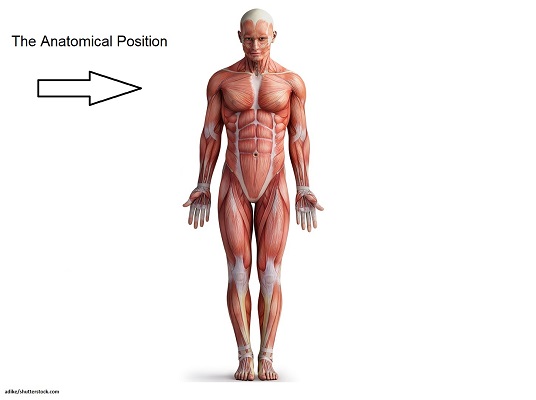
An easy way to remember this is to imagine that you’re walking to the parking lot, and you see someone spray painting graffiti on your car. You’d probably scream, “What are you doing?!” with your hands to your side. That’s basically the anatomical position. If you practice doing it a few times, you’ll never forget it.
It’s important for you to remember the anatomical position, because that’s the standard perspective everyone uses when talking about anatomy and the directional terms. By using a standard point of reference, you can ensure that everyone will understand what you’re talking about when you refer to the anterior side of the left forearm, for example. Left will be left from the perspective of the anatomical position, and anterior will be the front of the body (the side with abdominal muscles) in the anatomical position.
Anatomy and physiology is a course that builds on the material from the previous chapters, so if you learn the meaning of terms like superior or inferior early in the semester, then you’ll understand intuitively that the superior vena cava is going to be above the inferior vena cava in the heart.
In addition, you’ll probably by using these directional terms often when you’re documenting as a nurse or healthcare worker, so this is something that can be practical to your career.
Anatomy Directional Terms
Here’s an important tip for understanding directional terms: they are usually grouped in pairs of opposites. If you can learn the meaning of at least one of the directional terms in a pair, you can easily know the meaning of the opposing directional term.
Here are the directional terms that I’ll be covering:
- Superior (cranial) and inferior (caudal)
- Anterior (ventral) and Posterior (dorsal)
- Distal and proximal
- Superficial and deep
- Medial, lateral, and intermediate
The first pair of directional terms refer to the relative position toward or away from the head.
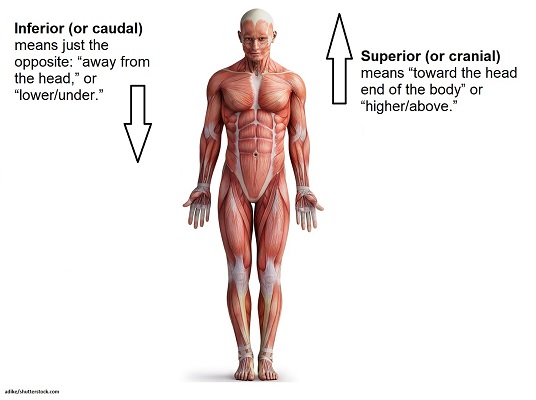
- Superior (or cranial) means “toward the head end of the body” or “higher/above.” You can remember this because the head of a company is your superior at work. He or she holds a “higher” position than you do. They are above you in authority.
- Inferior (or caudal) means just the opposite: “away from the head,” or “lower/under/below.” An inferior product has a “lower” quality of material compared to something else.
An anatomy quiz may ask this: The eyes are superior to the mouth: true or false? That’s true. The chest is inferior to the neck, and so on.
The next pair of directional terms relate to the front or back of the body or structure, relative to another structure.
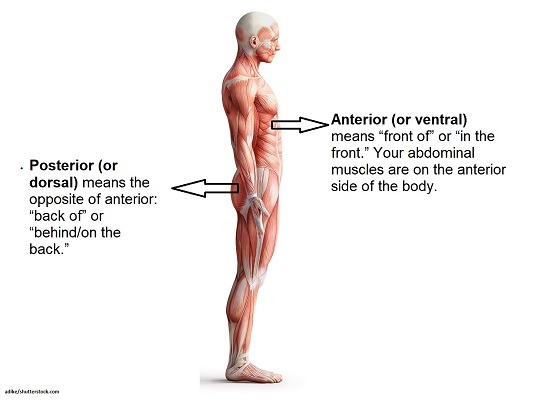
- Anterior (or ventral) means “front of” or “in the front.” Your abdominal muscles are on the anterior side. Abs=anterior side. The word ventral literally means belly!
- Posterior (or dorsal) means the opposite of anterior: “back of” or “behind/on the back.” This is easy to remember because “posterior” is another word for your rear end, which is on your backside.
An anatomy test question might ask, “Your sternum is ________ to your spine.” The answer is that your sternum is anterior to the spine. Your intestines are posterior to your abdominal muscles.
Next, we have distal and proximal, which relate to the attachment point or origin of a structure to your body, such as your arms and legs attaching to your trunk.
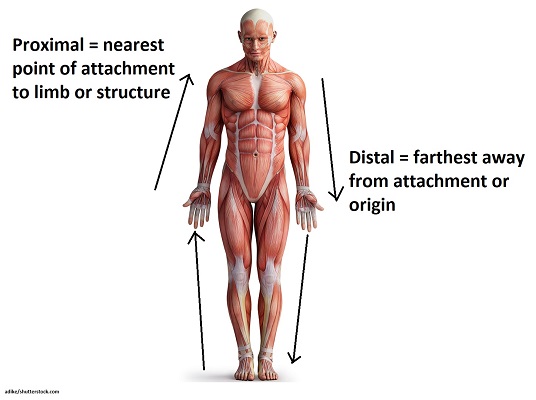
- Distal means “away from” or “farthest from” the attachment point of the structure (hip for legs or shoulders for arms). You literally “go the distance” with distal.
- Proximal is the opposite of distal. It means “closest to” or “nearest” the point of origin of a structure, such as your limb in relation to your trunk. Just think of the word “approximately,” and you’ll remember that it means “close to” the insertion point on the trunk.
An easy way to remember this is to hold a pistol in your hand, and remember this phrase: the pistol is distal to your upper arm.
Your fingers (phalanges) would be distal to your wrist bones (carpals). Your femur bone in your upper leg would be proximal to your ankle bones (tarsals).
The next directional pair refers to the position of a structure relative to the body’s surface. These are easy to remember because they are common words that we all use.
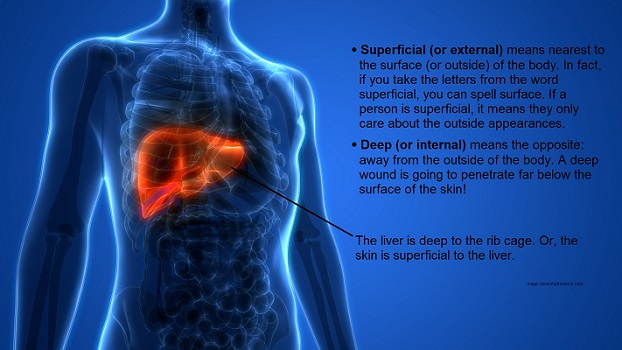
- Superficial (or external) means nearest to the surface (or outside) of the body. In fact, if you take the letters from the word superficial, you can spell the word “surface.” If a person is superficial, it means they only care about the outside appearances (what’s on the surface).
- Deep (or internal) means the opposite: away from the outside of the body. A deep wound is going to penetrate far below the surface of the skin!
The liver is deep to the rib cage. The skin is superficial to the liver. The muscles are deep to the skin, and the skin is superficial to the kidneys.

Finally, we have terms that refer to a structure’s location relative to the midline of the body.
- Medial means toward the midline of the body. It’s easy to remember because medial sounds like “middle.”
- Lateral means away from the body’s midline. It’s easy to remember because a popular exercise for the shoulders is lateral raises, in which you raise your arms away from the body’s midline.
- Intermediate means “between” two structures.
Your knee is intermediate between your ankles and hip. Your sternum is medial to your humerus, and your deltoid (shoulder muscle) is lateral to your pectoral (chest) muscles.
Ready to test your knowledge? Take our free (and quick!) directional terms quiz. Also, you might want to watch more of our anatomy and physiology lectures on YouTube.